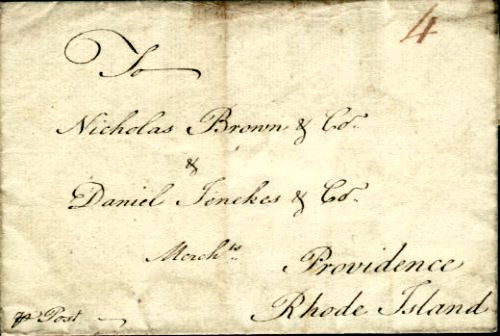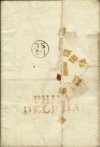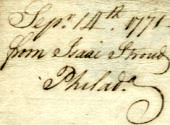![]()
Postal History Introduction
Stampless
Covers
1846
to 1900 Issues
1901-1950
Issues
1951-2003
Issues
Cancels
&
Miscellaneous
Postal
Stationery
Post
Cards
Air
Mail
First
Day &
Event Covers
Parcel Post/Special Delivery
Registered & Official Mail
Commercial & Advertising
Revenue & Postage Due
Wildlife & Game Issues
Complete List of RI Issues
|
Rhode Island Stampless
Covers & Letters |
|||
|
|||
|
This item is just the cover with no contents. The historical value of the item in addition to the early date and its connection to the Four Brown Brothers of Providence, Rhode Island is in the relatively rare Philadelphia Straight Line Cancel and the Franklin Mark found on the reverse of the cover. |
||
|
This letter was sent at the British Colonial Rate of 4 Pence - established in 1765 for mail sent via overland post from any Colonial City to any other Colonial City . The Philadelphia Straight line Cancel on the reverse of this cover is a Back-Stamp used between the years 1764 and 1775. It is found only in Red and measures 16 x 53 mm. Above the Back-Stamp is a small Circle Date (CD) with 14 SE inside which denotes September 14th. Covers of the colonial and pre-1800 period are frequently found bearing one or more of this type of CD marking. The day appears at top with the month abbreviated below. The CD is usually between 15 and 17 mm in diameter. The British version of this CD has a horizontal line between the day and month and is known as a Bishop Mark. The American version as illustrated on the reverse of this cover does not have the horizontal line and is known as a Franklin Mark. The cover with the Philadelphia Straight-Line Cancel and Franklin Mark retails for between $1000 and $1200. Nicholas Brown & Company The Reverend Chad Brown landed in the Massachusetts Bay colony in 1638 with his wife Elizabeth and young son John. Shortly after arriving, Chad and his family moved to Providence, Rhode Island where he became the Pastor of the Providence Baptist Church in 1642. The great-grandson of Chad Brown, James Brown II, laid the foundations of the Brown family wealth. James and his second wife, Hope Power Brown were the parents of five sons; James, John, Joseph, Moses, and Nicholas. The last four of these brothers further established the mercantile empire of the Brown family and are known in Providence history as "The Four Brothers." Nicholas Brown, the eldest of the four brothers was born in Providence on July 28, 1729. Nicholas Brown's first wife was Rhoda Jenckes, the daughter of Judge Daniel Jenckes, (the second addressee on the cover above). Nicholas was a highly successful merchant all of his life, entering the business of his father James and Uncle Obidiah at an early age. The Browns were one of the first of the Rhode Island merchant families to enter into the slave trade. James Brown, the father of the Four Brothers, first ventured into the trade in 1736 with his sloop Mary, but never made another voyage. James died in 1739 leaving his four sons in the care of his younger brother Obidiah. Obidiah attempted another unsuccessful slaving voyage in 1759, which ended his interest in the trade. In 1762 Nicholas, John, Joseph and Moses started a candle works and in that same year, the four brothers established the firm, Nicholas Brown & Company to handle their other commercial and shipping ventures. John Brown convinced his brothers to enter the slave trade again in 1764 with Esek Hopkins, (later the First Commander in Chief of the United States Navy) as master of their brig Sally. Nicholas Brown & Company left the slave trade in 1767, however brother John, although remaining a member of the firm, continued in the trade on his own into the early 1800s. During the revolution the firm under Nicholas' and John's guidance engaged in privateering against British merchant ships. With the retirement of Joseph and Moses from the firm in 1782; the firm was joined by George Benson and the company became known as Brown and Benson. In 1787, John Brown became the first of the brothers to enter the Far Eastern Trade, (China Trade), sending his ship General Washington to Canton with a cargo of anchors, cannon shot, iron, copper, ginseng, rum, wine and brandy. When Nicholas Sr., died in 1791, his son Nicholas Jr. took over the reins of the firm and in that same year the firm was joined by his sister's husband Thomas Poynton Ives and became Brown and Ives. Brown and Ives entered the China Trade in 1794 with their ship John Jay, returning after a two year voyage with a cargo valued at $250,000.00. Another of Brown and Ives ships named Ann and Hope after the partners wives, completed 6 China trips before being wrecked off of Block Island. By the turn of the century Brown and Ives had a large fleet of ships engaged in the China Trade, which included a second Ann and Hope and the Charlotte, Friendship, Hamilton, Harmony, Hope, Isle Asta, President Washington, Rising Sun, and the Three Friends. The Brown family's many and varied businesses continued to prosper and grow, however by the mid 19th century, the firm's shipping business was much reduced and most of their endeavors were tied to manufacturing and the textile industry. The Brown family contributed to the city of Providence in numerous ways and are responsible for many of the City's Firsts including; the first Paving of the City Streets, the building of the Town Market Place and Brown University. In addition, John Brown was instrumental in the famous burning of the British Revenue Ship Gaspee. Daniel Jenckes Daniel Jenckes was the Chief Justice of the Inferior Court of Common Pleas for Providence County. Judge Jenckes was also the father of Rhoda Jenckes, who was the first wife of Nicholas Brown. In 1764 Daniel Jencks and Nicholas Brown along with Governor Hopkins were appointed by the General Assembly to consult on any necessary measures to secure a repeal of the "Sugar Act." Isaac Stroud The only two references to the sender, I have been able to find so far, list Isaac Stroud as a witness to a bond and a land indenture for Henry Elwes on July 23, 1764. See below links for further information: The History of Brown and Ives with Brown family Genealogy 1789 Brown and Benson
Letter from Champion and Dickason - London Sources: |
|||

RI Historical
Society
Introduction
Stampless I
Stampless II
Stampless III
Stampless IV
Stampless V
Stampless VI
Brown & Ives Letters
The Hazard Family Letters
Joseph Tillinghast
Free Franked Letters
DeWolf Family Letters
Recently Added Pages


